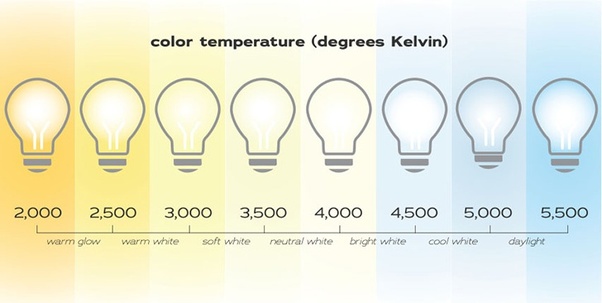Now that you’ve taken the steps to space plan, select the right furniture, and set the feature colors in your office, it’s time to draw attention to your lighting. Lighting is an essential part of the overall design of any space, and is of particular importance when designing it for a work area. A home office allows the opportunity to take a break from the harsh, eye-straining fluorescent lighting you’ve likely adjusted to in a typical office setting. To help the character and quality of lighting in your workspace, consider three lighting elements: temperature of light, ambient lighting, and task lighting. These guidelines will help you achieve a perfect balance of light when natural light is low or unavailable.
COLOR TEMPERATURE OF LIGHT
The Kelvin scale is used to measure the temperature of light, in which the lower the temperature, the warmer the light tone, and the higher the temperature, the cooler or bluer the light source appears. A traditional incandescent bulb falls around the 2300K to 2700K mark, which has amber tones and an overall warm glow, sometimes referred to as “warm white”. These types of color tones work well for accent lighting or areas that call for a softer glow, such as a sconce or small bulbs on a chandelier in a cozy lounge. At the other end of the spectrum, you will find the ultra white lights, sometimes referred to as “daylight”, which are reminiscent of doctors offices and are equal to 5000K-6000K+. These bright, blueish lights are better fit for places like warehouses, garages, and hospitals.
Photo: Work space making use of natural light, ambient lighting, and task lighting.

AMBIENT LIGHTING
Ambient lighting such as overhead, recessed, or track lights illuminate the space in general, providing an overall level of light in that space. They are the foundation for lighting up a room, however, you should not rely on them to be your only source of illumination. You can incorporate other types of ambient lighting such as a flush mount ceiling light, chandelier, or large pendant to add interest and complement the decor of your office. As a general rule of thumb, chandeliers and pendants should hang in the center of your room with the bottom of the fixture no lower than 6 feet above the finished floor.
Photo Above: The graphic above shows the Kelvin scale from lower temperatures (warmer tones) to higher temperatures (cooler tones).
TASK LIGHTING
Task lighting provides a focused light source and is essential for demanding visual tasks such as reading, writing, and working in front of a computer. These lights focus on the particular area where the task is performed and are ideally brighter than your ambient lighting. It is important to note the placement of your task lighting: make sure to position your light source on the opposite side of your writing hand to avoid shadows cast from your arm, and position bulbs away from your screen to avoid glare. Be sure to provide a task light for each task location, such as a floor lamp in your reading nook, a desk lamp on your work desk, and a pendant light over your work table. Playing with different types of fixtures will create interest while adding function and distinction between each work area.
Photo: Even an office with a dark ceiling can strike lighting balance by way of ambient lighting in the ceiling and intentional task lighting.
NATURAL LIGHTING
While we did not focus on natural lighting on this post, it goes without mention that you should definitely take advantage of natural lighting whenever possible. Several studies have found that natural lighting is beneficial to a workspace by improving mood and promoting productivity. Daylight can provide ambient lighting, which you can compliment with artificial task lighting.
Photo: In this work space, attention has been set to light each task area with a light source.
